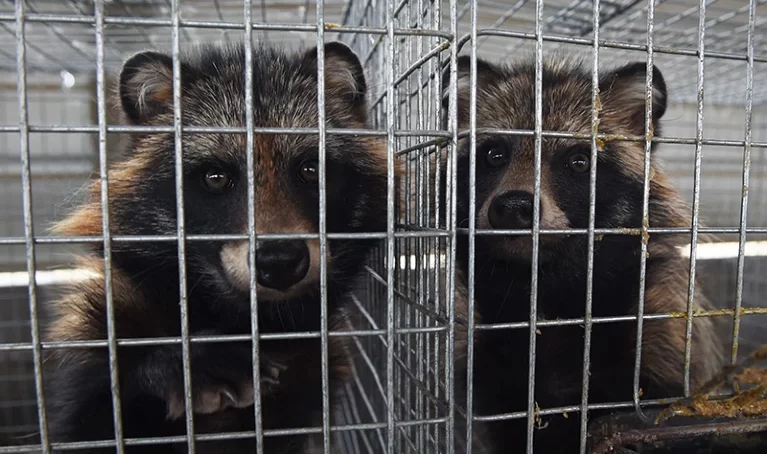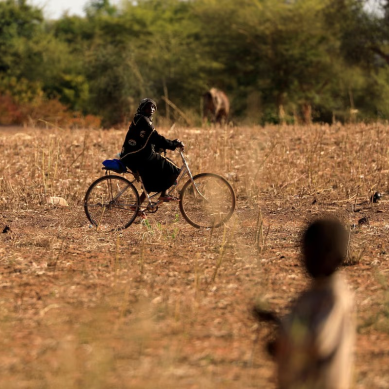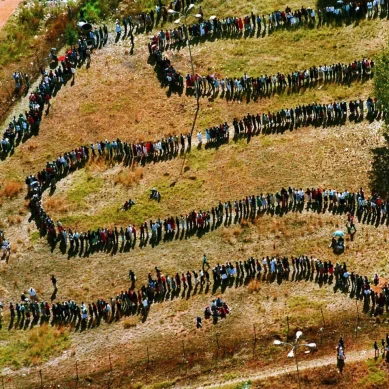
Raccoon dogs, bamboo rats, palm civets: these are just some of the animals whose DNA has been found in swabs taken from the Huanan Seafood Wholesale Market in Wuhan, China, which has been linked to the origin of the Covid-19 pandemic.
The swabs also tested positive for SARS-CoV-2, which causes the disease. The analysis – posted on March 20 to the research repository Zenodo – provides evidence supporting the hypothesis that SARS-CoV-2 spilled over from animals to humans at the market, say some researchers.
“Of course, this is not direct evidence,” says Leo Poon, a virologist at the University of Hong Kong, “but this is the best we can get now, because all the animals have been eliminated from the market and we don’t have swabs of the animals.”
On March 16, The Atlantic first reported on the analysis. The Zenodo posting, which has not been peer reviewed, is the first time that the full work has been released publicly, which could pave the way for follow-up studies, such as an investigation of where the animals in the market came from.
The swabs were collected in early 2020, after the market was shut down and cleared of animal products.
The researchers were specifically interested in looking for evidence of mammals, which could have been intermediate hosts of the virus. They identified near-complete mitochondrial DNA sequences – some 16,000-base-pairs long – for five species of wildlife, including raccoon dog (Nyctereutes procyonoides), Malayan porcupine (Hystrix brachyura), Amur hedgehog (Erinaceus amurensis), masked palm civet (Paguma larvata) and hoary bamboo rat (Rhizomys pruinosus).
“It’s remarkable to have a list,” says study co-author Alex Crits-Christoph, who is a computational biologist at a non-profit organisation and is based in Baltimore, Maryland.
Particularly notable was the raccoon dog mitochondrial DNA found in six samples from two stalls. Research has shown that raccoon dogs – small fox-like animals – are susceptible to SARS-CoV-2, and can spread the infection to other raccoon dogs without showing clear signs of sickness.
Raccoon dogs and masked palm civets have also been found with infections of viruses that are almost identical to the one that causes severe acute respiratory syndrome (SARS), which is related to SARS-CoV-2 and caused an outbreak in people in 2003. And work in palm-civet cells indicates that the creatures could possibly become infected with SARS-CoV-2.
Studies suggest that a progenitor of SARS-CoV-2 probably originated in bats, but how it passed from bats to people is not clear. Scientists suspect an intermediate host was involved, but they have not found strong evidence, which has led to speculation that the virus could have instead leaked — deliberately or accidentally — from a laboratory in Wuhan.
The new study does not confirm whether the animals themselves were infected with the virus. But establishing that the animals were present at the market supports the hypothesis that the pandemic had an animal origin, say some researchers.
The information could be used to track where the animals in the market came from, which could inform efforts to understand the pandemic’s start.
Others are more cautious about drawing conclusions on the origins of the pandemic from the analysis. The work confirms which animal species were at the market, but because it includes only samples that had tested positive, “there is no data in this work associating SARS-CoV-2 with the presence of any of these animals”, says Justin Kinney, a quantitative biologist at Cold Spring Harbour Laboratory in New York.
“These data do not provide a definitive answer to the question of how the pandemic began,” said Tedros Adhanom Ghebreyesus, director-general of the World Health Organization (WHO), at a press event on March 17, after he had been briefed in advance of the report’s release. “But every piece of data is important in moving us closer to that answer,” he said.
The swabs were originally referred to in a preprint paper by George Gao, former director of the Chinese Centre for Disease Control (China CDC) and colleagues, posted on Research Square in February 2022. Researchers have asked for that data to be made public on several occasions, without success.
But Florence Débarre, an evolutionary biologist at the French National Centre for Scientific Research, who is also a co-author of the latest report, discovered the data almost by chance on the public data repository GISAID on March 4. “Basically, [they’re] the ones we’ve been waiting for, for a year,” she says.
In total, Débarre and her colleagues downloaded around half a terabyte of genomic data from some 50 samples. The data included almost all the swabs taken from drains, market stalls and the ground between January and February 2020 that had tested positive for SARS-CoV-2. “We’re talking about millions and millions of sequencing reads,” says Crits-Christoph.
But soon after the researchers downloaded the data, it disappeared from public view on GISAID.
A spokesperson for GISAID told Nature in an e-mail that it does not delete records, but that contributors often update their records, and, during that time, records “become temporarily invisible”. The market-swab data “are currently being updated with newer and additional data as part of a manuscript currently under review”.
Débarre and her colleagues say they reached out to authors of the preprint to collaborate on the analysis, but the China CDC declined. On March 14, her colleagues, as well as members of the China CDC, presented their work to the WHO at a meeting of the Scientific Advisory Group for the Origins of Novel Pathogens, a body tasked with investigating outbreaks, including the origins of SARS-CoV-2.
At the WHO press briefing on March 17, Tedros called on the China CDC researchers to be transparent in sharing data. “These data could have and should have been shared three years ago,” he said.
Gao did not respond to Nature’s requests for comment.
Débarre recognises that it has taken a long time to share this data, but acknowledges the environmental sampling and sequencing work conducted by the China CDC. “They did what needed to be done,” she says. “We wouldn’t have this data, if it wasn’t for their work.”
Previous studies have found that Chinese bamboo rats (Rhizomys sinensis) and raccoon dogs were sold at the Huanan market between May 2017 and November 20193, and that several stalls were probably selling live or freshly killed mammals or other meat products4. The data confirm that “exactly what we thought was there in the market, was there in the market”, says Joel Wertheim, a molecular epidemiologist at the University of California, San Diego, and another co-author of the analysis.
The area where most of the SARS-CoV-2-positive samples clustered was also where most of the samples containing wild-animal DNA were found, which Poon says “agrees with the hypothesis that maybe the virus came from animals”.
Positive swabs from the eastern section of the market primarily contained human DNA – suggesting that there was some human-to-human transmission at the market in early 2020, says Poon.
In one sample from a cart used to move cages, the researchers found RNA and DNA that matched the raccoon-dog genome, and very little that matched the human genome.
“The most logical hypothesis is that raccoon dogs were infected by SARS-CoV-2 and shed the virus,” says Poon.
But it is possible that the site was contaminated with SARS-CoV-2 RNA from other sources. “There is no evidence that the virus came from an infected raccoon dog; it could just as easily have come from an infected person,” says Kinney.
Many more forensic insights could still come from the data if they were made public again, says Crits-Christoph. For example, by looking at the ratio of RNA to DNA for different animal species, researchers could determine how recently those animals were present at the market, because DNA typically persists in the environment longer than RNA does. But more details are needed about how the samples were collected, processed and sequenced, says Wertheim.
A close study of the RNA data could possibly determine whether the animals at the market were sick, adds Crits-Christoph. Does it seem like the creatures were in “a disease state, or a healthy state?” he asks. “There’s all sorts of wonderful, complex questions in the data.”
There are more data that have not yet been shared, including environmental swabs that were negative for SARS-CoV-2, and detailed virus data. Those data are important to analyse, to get a better picture of what was happening at the market, says Wertheim.
- A Nature report











